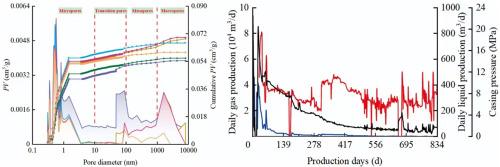Investigation on full-scale pore characterization and its implications for gas storage and development potential of deep coal seam in the Jiaxian block, NE Ordos Basin, China
IF 3.6
引用次数: 0
Abstract
Deep coal reservoirs (buried depth > 2000 m) represent a significant yet underexploited resource for coalbed methane (CBM) production. In these reservoirs, CBM primarily exists in adsorbed and free phase, with the pore structure playing a critical role in gas storage and migration. The Jiaxian block in the northeastern Ordos Basin, has emerged as a key area for deep CBM exploration due to its promising resource potential. However, the pore structure characteristics of the No. 8 coal seam in Jiaxian block and their implications for gas storage and production remain poorly understood. A comprehensive characterization of the No. 8 coal seam's pore structure is conducted in the study using multiple methods including high-pressure mercury injection, N2/CO2 adsorption experiments, and integration of measured core gas content data and production history. The study results reveal that the pores can be mainly classified as vesicles and cellular pores, and the fractures are mainly static pressure fractures. Micropores (pore diameter < 10 nm) dominate the pore system (accounting for more than 99 % of the total specific surface area), providing important adsorption sites for gas storage. Although mesopores (pore diameter of 100–1000 nm) and macropores (pore diameter > 1000 nm) account for a small proportion, they feature effective storage spaces and interconnectivity, resulting in a high proportion of free gas. Therefore, the reservoirs shows great development potential after stimulation (such as hydraulic fracturing). These findings emphasize the feasibility of large-scale and long-term development of CBM in the Jiaxian block in terms of reservoir space, gas content and production characteristics. This study serves to lay a scientific basis for its efficient exploitation.

鄂尔多斯盆地东北部嘉县区块深部煤层全尺度孔隙特征及其储气潜力研究
深层煤储层(埋深2000米)是煤层气生产的重要资源,但尚未得到充分开发。在这些储层中,煤层气主要以吸附相和自由相存在,孔隙结构对天然气的储集和运移起着关键作用。鄂尔多斯盆地东北部的嘉县区块资源潜力巨大,已成为深部煤层气勘探的重点区域。然而,对嘉县区块8号煤层孔隙结构特征及其储采意义尚不清楚。采用高压压汞、N2/CO2吸附实验、岩心实测含气量数据与生产历史相结合等多种方法对8号煤层孔隙结构进行了综合表征。研究结果表明:孔隙主要可分为囊泡孔和细胞孔,裂缝主要为静压裂缝;微孔(孔径为10 nm)在孔隙系统中占主导地位(占总比表面积的99%以上),为储气提供了重要的吸附位点。虽然中孔(孔径100 - 1000nm)和大孔(孔径>; 1000nm)所占比例较小,但它们具有有效的存储空间和互联性,导致游离气体的比例较高。因此,经过改造(如水力压裂)后,储层具有很大的开发潜力。这些研究结果从储层空间、含气量和生产特征等方面强调了嘉县区块大规模、长期开发煤层气的可行性。本研究为其有效开发利用奠定了科学依据。
本文章由计算机程序翻译,如有差异,请以英文原文为准。
求助全文
约1分钟内获得全文
求助全文

 求助内容:
求助内容: 应助结果提醒方式:
应助结果提醒方式:


